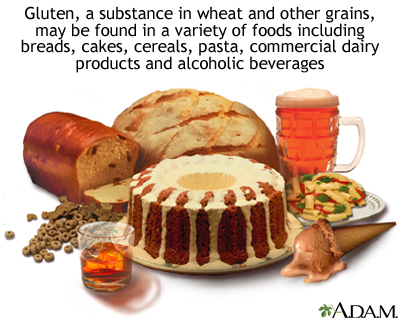Celiac disease - nutritional considerations
Definition
Celiac disease is an immune disorder passed down through families.
Gluten is a protein found in wheat, barley, rye, or sometimes oats. It may also be found in some medicines. When a person with celiac disease eats or drinks anything containing gluten, the immune system responds by damaging the lining of the small intestine. This affects the body's ability to absorb nutrients.
Carefully following a gluten-free diet helps prevent symptoms of the disease.
Alternative Names
Gluten sensitive enteropathy - diet; Celiac sprue - diet
Food Sources
To follow a gluten-free diet means, you need to avoid all foods, drinks, and medicines made with gluten. This means not eating anything made with barley, rye, and wheat. All items made with all-purpose, white, or wheat flour are prohibited.
FOODS YOU CAN EAT
- Beans
- Cereals made without wheat or barley malt
- Corn
- Fruits and vegetables
- Meat, poultry, and fish (not breaded or made with regular gravies)
- Milk-based items
- Gluten-free oats
- Potatoes
- Rice
- Gluten-free products such as crackers, pasta, and breads
Obvious sources of gluten include:
- Breaded foods
- Breads, bagels, croissants, and buns
- Cakes, donuts, and pies
- Cereals (most)
- Crackers and many snacks bought at the store, such as potato chips and tortilla chips
- Gravy
- Pancakes and waffles
- Pasta and pizza (other than gluten-free pasta and pizza crust)
- Soups (most)
- Stuffing
Less obvious foods that must be eliminated include:
- Beer
- Candies (some)
- Cold cuts, hot dogs, salami or sausage
- Communion breads
- Croutons
- Some marinades, sauces, soy, and teriyaki sauces
- Salad dressings (some)
- Self-basting turkey
There is a risk for cross-contamination. Items that are naturally gluten-free may become contaminated if they are made on the same production line, or moved together in the same place, as foods containing gluten.
Eating at restaurants, work, school, and social gatherings can be challenging. Call ahead and plan. Due to the widespread use of wheat and barley in foods, it is important to read labels before buying food or eating.
Despite its challenges, maintaining a healthy, balanced diet is possible with education and planning.
Recommendations
Talk to a registered dietitian who specializes in celiac disease and the gluten-free diet to help you plan your diet.
You may also want to join a local support group. These groups can help people with celiac disease share practical advice on ingredients, baking, and ways to cope with this life-altering, lifelong disease.
Your health care provider might suggest you take a multivitamin and mineral or an individual nutrient supplement to correct or prevent a deficiency.
Gallery

References
Lebwohi B, Green PHR. Celiac disease. In: Feldman M, Friedman LS, Brandt LJ, eds. Sleisenger and Fordtran's Gastrointestinal and Liver Disease: Pathophysiology/Diagnosis/Management. 11th ed. Philadelphia, PA: Elsevier; 2021:chap 107.
Rubio-Tapia A, Hill ID, Kelly CP, Calderwood AH, Murray JA; American College of Gastroenterology. ACG clinical guidelines: diagnosis and management of celiac disease. Am J Gastroenterol. 2013;108(5):656-677. PMID: 23609613 pubmed.ncbi.nlm.nih.gov/23609613/.
Shand AG, Wilding JPH. Nutritional factors in disease. In: Ralston SH, Penman ID, Strachan MWJ, Hobson RP, eds. Davidson's Principles and Practice of Medicine. 23rd ed. Philadelphia, PA: Elsevier; 2018:chap 19.
Troncone R, Auricchio R. Celiac disease. In: Wyllie R, Hyams JS, Kay M, eds. Pediatric Gastrointestinal and Liver Disease. 6th ed. Philadelphia, PA: Elsevier; 2021:chap 34.
